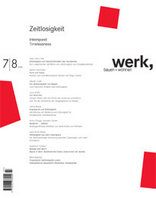Zeitschrift
werk, bauen + wohnen 7/8-02
Zeitlosigkeit
We tend to say that things are timeless almost as a matter of course, for example in the context of the new kind of Swiss architecture that is characterized by reduction to elemental design resources and rules. We obviously think the person we are talking to will know exactly what we mean. And so what is the position? - The contributions in this issue all work on the basis that „timelessness as such“ does not exist. The philosopher and art theoretician Hans Heinz Holz starts out by stating: „Every work of art, like every work of man, is historical. It acquires its form in relation to the circumstances of the time when it came into being and whose reflection in consciousness it expresses. Motifs, ways of looking at things, connotations of meaning are characteristic of their times.“ He writes this, but nevertheless investigates the question of what timelessness in great art is. While Holz insists that the validity of art forms above time is inherent in the work of art itself, Martin Steinmann turns his attention to perception theories, to the kind of productive seeing that can create „timelessness“. He talks about the „durability of form“, meaning the durability of its effect, which requires „that the effect of the form does not exhaust itself“. According to this, we could say: timelessness as such does not exist, but we produce it by lending a new validity to the objects and forms created for our time. There is thus a superficial contradiction: timelessness comes about at precisely the point when a structure that is already historical is adopted again as significant for the new times. Entirely in the spirit of Theodor Adorno, who writes in his essay „On Tradition“: „Insight into the content of the thing that it is renewing stands against the verdict of becoming obsolete“. So as every age has to adopt traditional things again, traditional things drop out of history if they do not find any significance in the present. That is to say: every age creates its own timelessness for itself; timelessness has a very high time content. This issue also addresses some contemporary architects and buildings concretely about their timeless qualities. While Roger Diener says that his architecture seems to carry old and new buildings within it, Luca Ortelli describes Giorgio Grassi's design as showing an increasing level of reduction. He says that his aim is „to measure himself with the past one to one, following the same rules that architecture has always used here.“ Jacques Lucan on the other hand feels that Livio Vacchini's search for universally valid rules and his striving for timelessness is condemned to failure from the outset. Hans Ernst Mittig approaches the theme from an entirely different angle by examining how an appearance of timelessness is created with a view to prestige, as architecture comes close to the world of Cyberspace, with its characteristic immateriality. And if questions come up in this or that essay that seem to contradict others, then we can confidently cling to Hans Heinz Holz's dialectical solution; he sums up by saying: "„Timeless“ is (..) not the opposite of historical, of being characteristic of the times; in fact it is precisely the historically determined element, in other words the singular, that is timeless if it reveals a general world condition."
Irma Noseda
Irma Noseda
Weiterführende Links:
Verlag Werk AG







